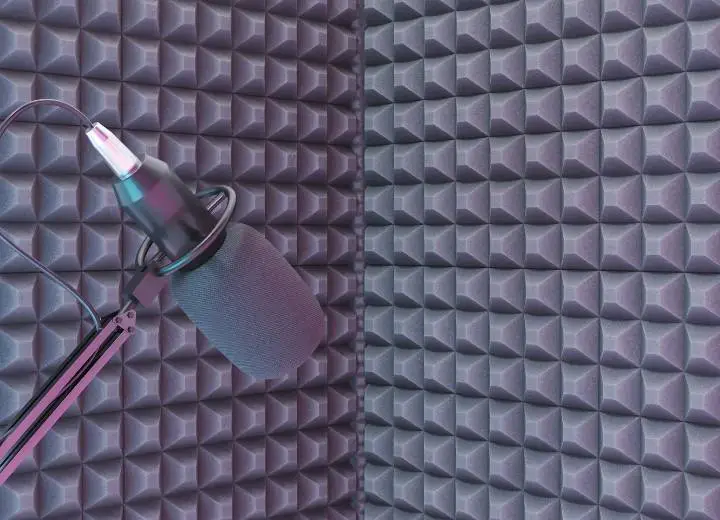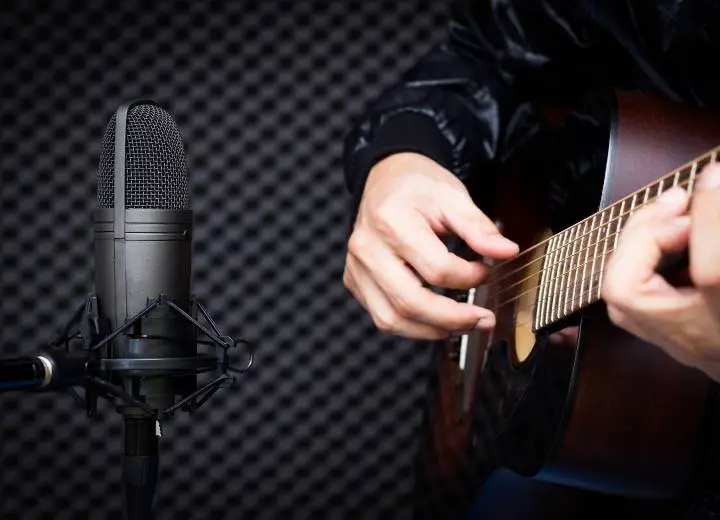
Why do recording studios have foam on the walls?
People install the foam on the walls in recording studios to control noise levels, vibrations, and echoes.
Not only for recording studios, but people also often use foam for cinemas, churches, and restaurants.
Types of soundproofing foam that people commonly use for recording studios include:
- Sound absorbing foam
- Sound blocking foam
In fact, both types of foam have different properties and use. Therefore, they are not interchangeable.
However, many people still often confuse them with each other and use them for the wrong purpose.
We will learn more about them in the article.
A closer look at the sound
Before learning about soundproofing foam, you should learn about the characteristics of sound first.
In short, sound is essentially a vibration of energy. Through the air, these vibrations will reach your ears as sound waves.
When the air inside your ear starts to vibrate, you can feel something called music, noise…
Through much research, they have realized that certain materials can affect the way sound waves behave.
For example, sound energy can penetrate hard surfaces. However, it may deform when in contact with soft surfaces.
From there, people began to research sound insulation.
Blocking sound and absorbing sound
Many people make the mistake of defining the difference between sound blocking and sound absorption.
Therefore, they often use them interchangeably. In fact, there is a clear difference between blocking sound and absorbing sound.
As you know, black objects absorb light while white objects reflect light. The degree of sound absorption or reflection is also variable between materials.
There are foams that can block sounds from the outside world. Meanwhile, others have the ability to absorb sound in the room to reduce reverberation.
Therefore, it is important that you know exactly what you need before choosing any solution.
Sound absorbing foam
It is true to say that the main role of sound-absorbing foam is to absorb sound.
If you walk into a closed room and clap your hands, you will get an echo back. It is the result of sound bouncing off the walls, floor, and ceiling into the room.
Compared with sound blocking foam, sound-absorbing foam is usually softer and lighter. It comes with a flexible and open-cell structure.

Therefore, it has the ability to absorb sound waves. That means it helps to eliminate echoing noise from walls, ceilings, floors.
Its mechanism of action is to convert sound energy into heat. Thanks to that, it has the ability to reduce the sound waves bouncing back into the room.
Depending upon how you set it up, sound-absorbing foam can enhance the acoustics in the room. Sound absorbing foam usually has wedge or pyramid shapes.
As a result, it can adjust vibrations to improve sound quality in the studio.
People often use sound-absorbing foam for soundproof rooms, cinemas, churches, etc.
Sound blocking foam
Unlike sound-absorbing foam, sound blocking foam does not have the effect of absorbing sound. Instead, it has the effect of preventing noise from traveling through walls.
Therefore, it has opposite properties compared to sound-absorbing foam. Specifically, it is heavier and more massive.
As mentioned above, sound-absorbing foam comes with a flexible and open-cell structure.
Meanwhile, sound blocking foam is the opposite. It comes with a closed-cell structure. The thicker and denser the sound blocking foam, the better the ability to block noise from traveling through the wall.
If your studio is near a noisy area, you need to block this sound from entering the studio. It is wise to choose sound-blocking foam.
It is very effective at preventing sound from traveling through walls and ceilings into the interior. Therefore, it is a great solution for your studio.
Frequently Asked Questions
1. What material should I use for sound absorption?
There are many materials available for you to choose from. Here are the most popular options:
- Acoustic Foam Panels
- Acoustic Mineral Wool
- Sound Absorbing Underlayment
- Acoustic Partitions
- Acoustic Cotton Batts
- Hanging Baffles
- Acoustic Fabric Panels
- And more
2. Foam is a good sound absorber, isn’t it?
The short answer is yes. It has the ability to absorb unwanted noises. That’s the reason why you often see it at the studio, cinema, theater, etc.
3. Is acoustic foam actually soundproof?
The short answer is no. Acoustical foam does not have the ability to block sound. It allows sound to pass through.
In fact, many manufacturers have used acoustic foam to cover the speaker grilles.
4. Can egg cartons absorb sound?
Egg cartons come with a corrugated structure. They cannot absorb all sound waves. Instead, they break down these sound waves into various frequencies. It then bounces these sound waves in different directions.
As a result, egg cartons are capable of reducing consequential noise.
5. Can I put soundproof foam in the dryer?
Soundproof foam will lose its effectiveness if it gets wet. To clean it, it is best to use a damp rag to remove dust. If the soundproof foam is damp, you can dry it with a hairdryer.
Conclusion
For your recording studio to be perfect, it must accommodate both blocking sound and absorbing sound. Your studio needs to absorb the sound inside the room while being able to block out sounds from the outside.
It is best to consider carefully before choosing any solution for your studio.
